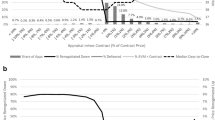Abstract
A real estate market model characterized by incomplete information, costly search, and varying expectations is presented. The model describes a self-selection process for market participants and a distribution of transaction prices. These transaction prices, which arise from a Nash equilibrium, can be expressed as a noisy signal, reflecting incomplete information as well as the conditions of sale. The appraiser's role is formalized as the task of signal extraction. The model emphasizes the differences in information available to individual buyers and sellers, who make transactions only infrequently, and the appraiser, whose expertise comes from observing many transactions. Based on the model, it is shown that contrary to popular perceptions, appraisal smoothing is consistent with an optimal updating strategy.
Similar content being viewed by others
References
Anderson, B.D.O. and Moore, J.B. Optimal Filtering, New Jersey: Prentice-Hall Inc., 1979.
Binmore, K. and Dasgupta, P., eds., The Economics of Bargaining. London and New York: Basil Blackwell, 1987.
Brueggeman, W.B., et al. “Real Estate Investment Funds: Performance and Portfolio Considerations.” AREUEA Journal 12 (Fall 1984), 333–354.
Burdett, K., and Judd, K. “Equilibrium Price Dispersion.” Econometrica 51 (July 1983), 955–969.
Chow, G. “Random and Changing Coefficient Models.” In Handbook of Econometrics, ed. by Z. Griliches and M.D. Intriligator, Vol. II, Elsevier Science Publishers, 1984.
Fama, E. and Schwert, G. “Asset Returns and Inflation.” Journal of Financial Economics 5 (November 1977), 115–146.
Firstenberg, P.M., et al. “Managing Real Estate Portfolios.” Goldman Sachs Real Estate Research Publication, November 1987.
Fishburn, P. and Rubinstein, A. “Time Preference,” International Economic Review, 23 (October 1982), 677–694.
Geltner, D. “Estimating Real Estate's Systematic Risk from Aggregate Level Appraisal-Based Returns.” AREUEA Journal 17 (Winter 1989), 463–481.
Hartzell, David, et al. “Diversification Categories in Investment Real Estate.” AREUEA Journal 14 (1986), 230–254.
Ibbotson, R. and Siegal, L.B. “Real Estate Returns: A Comparison with Other Investments.” AREUEA Journal 12 (Fall 1984), 219–242.
Kalman, R.E. “A New Approach to Linear Filtering and Prediction Problems.” J. Basic Eng., Trans. ASME 82, series D (March 1960), 35–45.
Lippman, S.A. and McCall, J.J. “The Economics of Job Search: A Survey.” Economic Inquiry XIV (September 1976), 347–368.
Miles, M. and McCue, T. “Commercial Real Estate Returns.” AREUEA Journal 12 (Fall, 1984), 355–377.
Miles, M. and McCue, T. “Historic Returns and Institutional Real Estate Portfolios.” AREUEA Journal (Summer, 1982), 184–199.
Milgrom, P. and Stokey, N. “Information, Trade and Common Knowledge.” Journal of Economic Theory 26 (1982), 17–27.
Quan, D., “Information, Prices and Common Value Search in Real Estate Markets.” Working paper No. 90/91-2-6, Finance Department, University of Texas at Austin, 1990.
Quan, D. and Quigley, J. “Inferring an Investment Return Series for Real Estate from Observations on Sales.” AREUEA Journal 17 (Summer, 1989), 218–230.
Reinganum, Jennifer F. “Strategic Search Theory.” International Economic Review 23 (February 1982), 1–17.
Rob, R. “Equilibrium Price Distributions.” Review of Economic Studies LII (1985), 487–504.
Ross, S. and Zisler, R. “Managing Real Estate Portfolios, Part 3: A Closer Look at Equity Real Estate Risk.” Goldman Sachs Real Estate Research, November 1987.
Rubenstein, A. “Perfect Equilibrium in a Bargaining Model.” Econometrica 50 (1982), 97–109.
Salop, S. and Stiglitz, J. “Bargains and Ripoffs: A Model of Monopolistically Competitive Prices.” Review of Economic Studies 44 (1976), 493–510.
Samuelson, P.A. “Proof That Properly Anticipated Prices Fluctuate Randomly.” Industrial Management Review 6 (1965), 41–49.
Samuelson, P.A. “Proof That Properly Discounted Present Values of Assets Vibrate Randomly.” The Bell Journal of Economics 4 (Autumn 1973), 369–374.
Sargent, T.J. Macroeconomic Theory, New York: Academic Press, 1979.
Shaked, A. and Sutton, J. “Involuntary Unemployment as a Perfect Equilibrium in a Bargaining Model.” Econometrica 52 (1984), 1351–1364.
Webb, J. and Sirmans, C.F. “Yields and Risk Measures for Real Estate, 1966–1977.” Journal of Portfolio Management (Fall 1980).
Weitzman, M. “Optimal Search for the Best Alternatives.” Econometrica 47 (1979), 641–654.
Wilde, L.L. and Schwartz, A. “Equilibrium Comparison Shopping.” Review of Economic Studies 46 (1979), 543–554.
Author information
Authors and Affiliations
Rights and permissions
About this article
Cite this article
Quan, D.C., Quigley, J.M. Price formation and the appraisal function in real estate markets. J Real Estate Finan Econ 4, 127–146 (1991). https://doi.org/10.1007/BF00173120
Issue Date:
DOI: https://doi.org/10.1007/BF00173120




